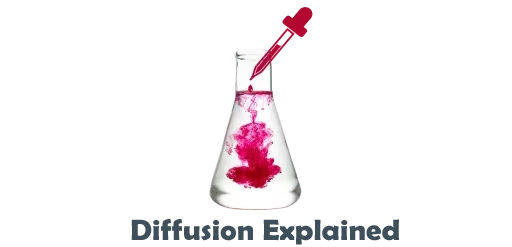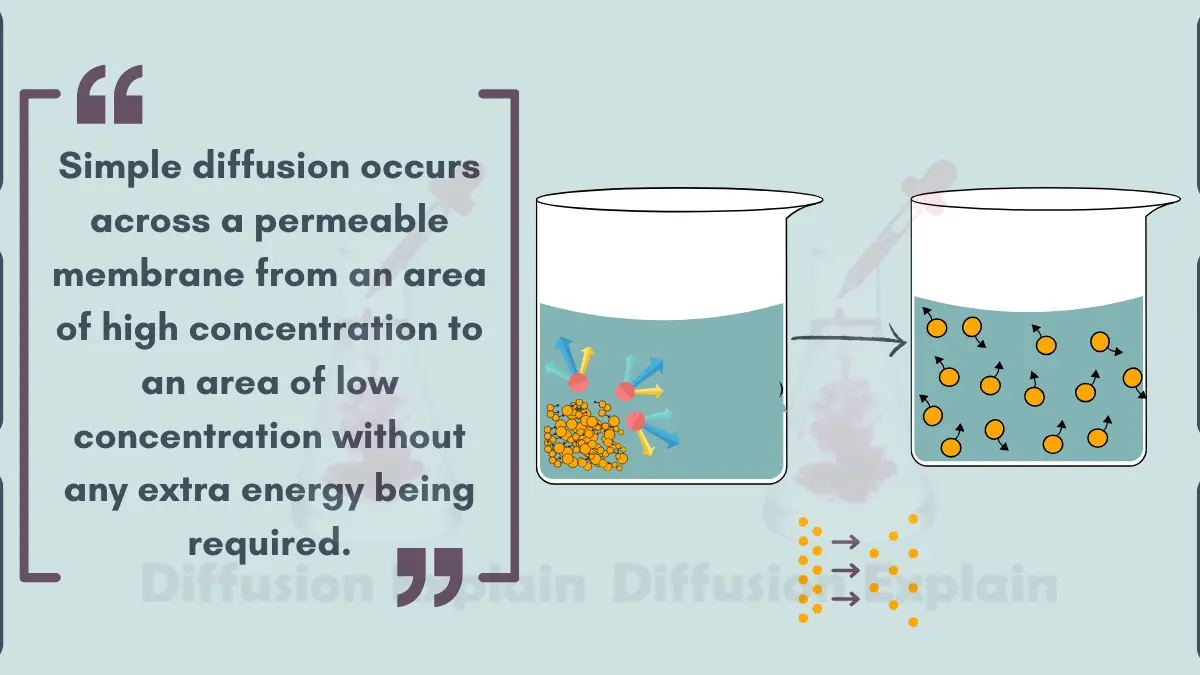What is Simple Diffusion?
Simple diffusion is a form of diffusion that does not require the help of membrane proteins. In simple diffusion, particles or substances move from areas of higher concentration to areas of lower concentration, going “downhill” due to concentration gradient. It does not involve membrane proteins to help transport the substances across the membrane.
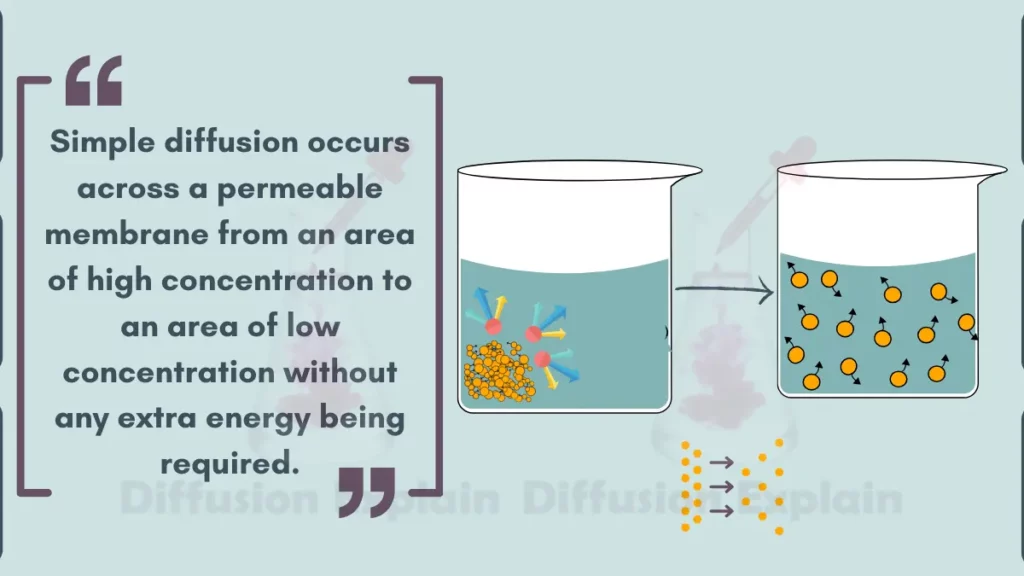
In biology, simple diffusion occurs across selectively permeable cell membranes. Solute molecules pass through the concentration gradient in a solution by the actions of temporary hydrogen bonds that form between the solutes and water molecules. The solution is constantly stirred, aiding even distribution of solutes. If molecules are small enough, they can diffuse directly through the phospholipid cell membrane in a process called osmosis.
Features of Simple Diffusion
Here are some main featured of Simple Diffusion:
- Simple diffusion is a passive transport method of diffusion. It’s a natural process where particles move from high to low concentration without needing energy.
- Particles move with the concentration gradient, driven by their own energy.
- Simple Diffusion is an Independent Process. It doesn’t need membrane proteins for movement. Particles pass directly through the membrane.
- Since its passive, it doesn’t need ATP energy to work.
- It moves solute particles, not solvent like in osmosis.
- It’s mainly for small, uncharged particles. Large molecules can’t pass.
- Simple diffusion is a universal process. It’s essential for gas exchange and water movement in cells.
- It helps to maintain Equilibrium of particle concentrations in cells.
- Simple Diffusion is a Continuous Process. It keeps happening as long as there’s a concentration difference.
Process of Simple Diffusion
Here are steps of mechanism of Simple Diffusion:
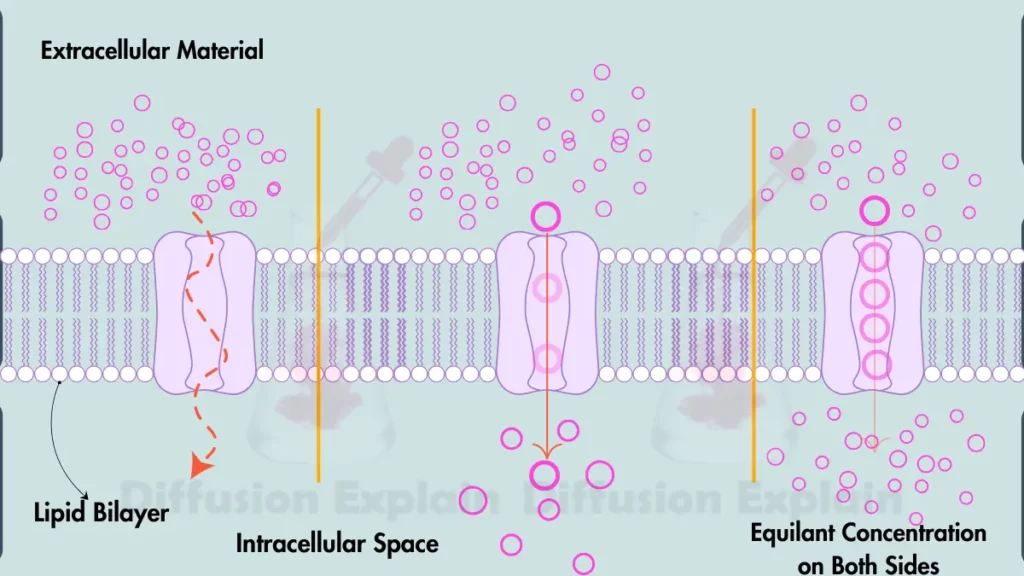
- Molecules in simple diffusion move due to their inherent kinetic energy and the difference in concentration between two areas. This difference is known as the concentration gradient.
- Molecules are constantly moving and colliding with each other (pedesis), resulting in random molecular motion.
- In areas of high concentration, molecules are closely packed together with restricted movement.
- When a molecule diffuses to an area of lower concentration, there is more space available. The molecule will move toward a lower concentration.
- The difference in concentration continues to drive diffusion as molecules move along the gradient from high to low concentration areas until equilibrium is reached.
Examples of Simple Diffusion In Biology
Here are a few more examples of simple diffusion in biology:
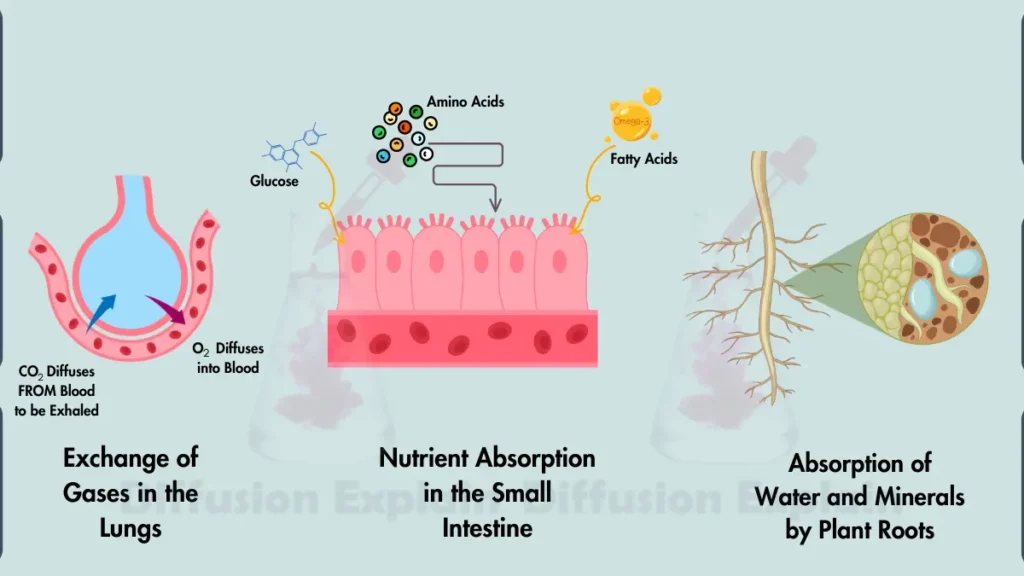
- Exchange of Gases in the Lungs – Oxygen from the air we breathe diffuses into the bloodstream in the lungs, while carbon dioxide from the bloodstream diffuses into the air in the lungs to be exhaled.
- Nutrient Absorption in the Small Intestine – Small molecules such as glucose and amino acids diffuse through the cells lining the small intestine into the bloodstream for distribution to the rest of the body.
- Release of Neurotransmitters – Neurotransmitter molecules diffuse across the synapse between two neurons, allowing for the transmission of signals between nerve cells in the brain and nervous system.
- Movement of Waste Products – Waste products such as urea diffuse from cells into the bloodstream for removal by the kidneys, where they are filtered out of the blood and excreted in urine.
- Absorption of Water and Minerals by Plant Roots – Water and mineral ions from the soil diffuse into the root cells of plants, allowing for the uptake of essential nutrients needed for growth and metabolism.
You can observe simple diffusion in action through practical demonstrations like a food coloring diffusion experiment where dye molecules spread naturally through water without external assistance.
Limitations of Simple Diffusion
Simple diffusion helps in many biological processes, But there are some limitiations too.
Molecule Size
The phospholipid bilayer of cell membranes has a “selectively permeable” nature. It means this phospholipid bilayer allows the passage of specific molecules based on size and charge. Large molecules like proteins, sugars, and even some starches, simply can’t pass through the tiny gaps between phospholipid molecules.
These larger molecules use alternative transport mechanisms like:
- Facilitated Diffusion – Carrier proteins act as “molecular taxis,” specifically binding to larger molecules and shuttling them across the membrane.
- Active Transport – This “uphill” (from lower to high concentration) process uses ATP energy to pump molecules against their concentration gradient, essential for transporting essential ions like calcium and potassium.
Charge
Charged ions like sodium (Na+) and potassium (K+) are attracted to water molecules (dipolar). This attraction creates a hydration shell around the ion, making it even larger and hindering its passage through the hydrophobic (water-fearing) interior of the membrane.
Similar to large molecules, charged ions primarily use:
- Facilitated Diffusion – Specific channel proteins create pathways for specific ions like Na+ and K+, allowing controlled movement across the membrane.
- Active Transport – Certain ion pumps, like the Na+/K+ ATPase, actively transport these ions against their concentration gradient to maintain vital cellular functions.
FAQs
Is simple diffusion a form of passive transport?
Simple diffusion is passive transport. It doesn’t require energy (ATP) to move molecules.
Why simple diffusion is sufficient for unicellular organism?
Simple diffusion suffices for unicellular organisms because:
1. Their small size and large surface area allow for efficient exchange of substances directly through the cell membrane.
2. They Lack internal barriers. So substances can readily diffuse throughout the cell using simple diffusion.
3. Simple diffusion meets their basic requirements for oxygen, nutrients, and waste removal.
Is simple diffusion high to low concentration?
Simple diffusion moves molecules from high to low concentration, following a concentration gradient.
Why does simple diffusion happen?
Simple diffusion happens because:
1: Particles have natural energy
2: Concentration gradient exists
3: No energy needed
Is simple diffusion typical for large molecules?
It’s not typical for large molecules due to their size. They need other mechanisms like active transport and facilitated diffusion for their transport.
